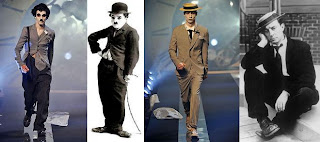 During the transition from silence to sound, Charlie Chaplin was the last bastion of silent cinema. In the subsequent years following the advent of sound, Chaplin had only flirted with using sound. THE GREAT DICTATOR is is first true talkie as well as his greatest financial success and last bona fide box office hit. The film is both hilarious and very political. Made during a time of neutrality between the United States and Nazi Germany, THE GREAT DICTATOR was a controversial stance. While numerous films dealing with similar anti-fascist sentiments were withheld from release, THE GREAT DICTATOR, through Chaplin's network of independent production, became an international success. The film's production was so controversial that even the President became involved to secure its completion and release. Chaplin, who sunk millions of his own money into the production, would have to live or die by THE GREAT DICTATOR.
During the transition from silence to sound, Charlie Chaplin was the last bastion of silent cinema. In the subsequent years following the advent of sound, Chaplin had only flirted with using sound. THE GREAT DICTATOR is is first true talkie as well as his greatest financial success and last bona fide box office hit. The film is both hilarious and very political. Made during a time of neutrality between the United States and Nazi Germany, THE GREAT DICTATOR was a controversial stance. While numerous films dealing with similar anti-fascist sentiments were withheld from release, THE GREAT DICTATOR, through Chaplin's network of independent production, became an international success. The film's production was so controversial that even the President became involved to secure its completion and release. Chaplin, who sunk millions of his own money into the production, would have to live or die by THE GREAT DICTATOR.Chaplin wrote, directed, produced, and starred in the film in dual roles: a Hitler-esque dictator and a Jewish barber. Chaplin had a strange fascination with Hitler and the film is further enhanced by the peculiar parallels in their respective biographies. It is rumored that Hitler was sent and watched the film (twice), but his response is unrecorded. Unlike films and propaganda at the time, THE GREAT DICTATOR is not a call to arms but rather a reminder of the humane, decent, and good. Chaplin showcases that comedy can be profoundly serious. Later in life, Chaplin remarked that if he had known the extent of the atrocities surrounding Nazi Germany, he would not have been able to make THE GREAT DICTATOR.
Suggested Supplmental Screenings: TRIUMPH OF THE WILL (Riefenstahl, 1935), MODERN TIMES (Chaplin, 1936), FURY (Lang, 1936), THE GRAND ILLUSION (Renoir, 1937), THE LADY VANISHES (Hitchcock, 1938), THE ETERNAL JEW (Hippler, 1940), TO BE OR NOT TO BE (Lubitsch, 1942)
.jpg)

.jpg)
.jpg)

.jpg)
.jpg)














